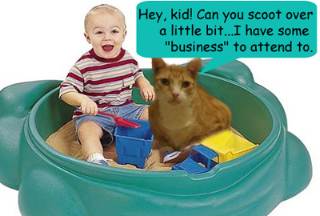Cats view sandboxes as a giant litterboxes.
Uncovered sandboxes can pose a threat to a child’s health if there is fecal matter in the sand. Dogs, raccoons, and especially cats may use this area as a bathroom space. These animals are known to carry many parasites, such as hookworms, roundworms, whipworms, tapeworms, and coccidia.
 If a child puts her fingers in her mouth, she can be infecting herself with the eggs of a parasite. In some cases, the hookworms will penetrate the skin, causing a condition called cutaneous larva migrans. In 2006, a summer camp in Florida reported an outbreak of cutaneous larva migrans involving 18 campers and four staff members. Cat feces in a sandbox was thought to be the source of the infection.
If a child puts her fingers in her mouth, she can be infecting herself with the eggs of a parasite. In some cases, the hookworms will penetrate the skin, causing a condition called cutaneous larva migrans. In 2006, a summer camp in Florida reported an outbreak of cutaneous larva migrans involving 18 campers and four staff members. Cat feces in a sandbox was thought to be the source of the infection.
Scott Weese, a veterinarian and publisher of the Worms and Germs blog, said recently,
"There’s certainly no indication that children should not go into sandboxes. These are extremely rare diseases that affect a very, very small number of people in North America every year."
But if a child puts a handful of sand in his mouth, that might just be the winning ticket to the parasite lottery.
Some preventative measures to keep the parasites out of the sandbox are:
~ Cover the sandbox when it is not in use. Commercial sandboxes come with covers, or a simple board with a brick on top of it will help to keep wild animals out of the sandbox.
~ Supervise children when they are playing in the sandbox and prevent them from putting their hands in their mouths.
~ Always, always, after coming in from playing outside, wash your hands.
